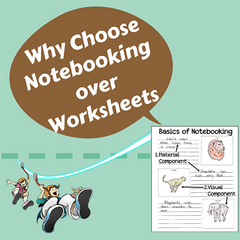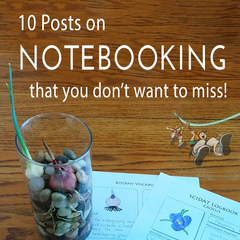Notebooking is a passion of mine, I much prefer it to worksheets because it requires the students to really think about the material they have read and respond with what they find to be meaningful.
I have already shared several of my organizational tips for notebooking in the past.
In this post, I want to answer some of the content-related questions that I often get when sharing about notebooking.
Let's dig in...
3 Content Related Tips For Notebooking
What Questions Should I Ask?
I always recommend discussing what the students read before asking for the narrations that you will serve as the material component of their notebooking pages. But I often get asked about how you know which questions to use.
If your science curriculum doesn't already provide options, you can use the following types of questions:
- Leading – This type of question is designed to pull out the most important information. (E.g., What are some differences between male and female lions?)
- Broad – This type of question will help you to see what material the students have absorbed. (E.g., What is one thing you have learned about lions?)
- General – This type of question will allow you to see what the students found interesting. (E.g., What did you find interesting about what we just read? or What do you remember from what we just studied?)
What Kinds Of responses Should I Expect From My Students?
There is no real clear cut answer for this because the response you get from your students will vary based on their writing abilities, listening skills, and narration experience.
Here are a few samples from our daughter's work to give you an idea:
In first grade, she scribbled over a picture of a lion as she dictated the following information to me for her notebooking page:
“Lions roar. Male lions have a mane. Lions are cats. Their cubs have spots”
In fourth grade, she colored a picture of a cheetah fairly accurately as she dictated and copied the following information for her notebooking page:
“Cheetahs are the fastest land animals in the world. They can go up to sixty miles an hour. Female cheetahs can have up to four babies at a time. Their babies are born with coat of long gray hair.”
In the sixth grade, she labeled a printed sketch of the dwarf birch before adding the following information to her notebooking page:
"The dwarf birch shrub is a low-growing bush found only in the tundra. Its small stature prevents damage from the arctic winds. The dwarf birch also has tiny hairs that trap water droplets and prevent moisture loss. Its dark green, thick, and leathery leaves are designed to be more efficient at photosynthesis. The dwarf birch shrub also has a large, wide-spread root system that allows it to grow just above the permafrost layer of the arctic taiga."
Your children's responses can and will vary, but at least this gives you an idea!
Where Can I Find Images For Our Notebooking Pages?
It's easiest to find a curriculum that already includes customized notebooking pages like our science curriculum does. But if that is not the case with what you are using or you are writing your own, here are a few ideas for finding pictures:
- Just type into Google the subject you are searching for plus "free coloring page" to find black-line images that you can print, cut, and paste onto a notebooking page.
- There's a chance that another homeschooler has already created a notebooking page for the subject you are learning about. If you type into Pinterest the subject plus "notebooking page" or "free printable" you might find an option that will work for you. Places like Notebooking Fairy, Mama's Learning Corner, Notebooking Pages, and CurrClick.com are great repositories for notebooking resources that we have used in the past.
You can also search through your own photos to see if you have something that will work.
Wrapping It Up
I trust that these tips for notebooking will help you as you seek to use this form of recording narrations with your students! If you have any more questions, feel free to join the discussion on the Sassafras Science Facebook page or send us an email through the contact button above.


